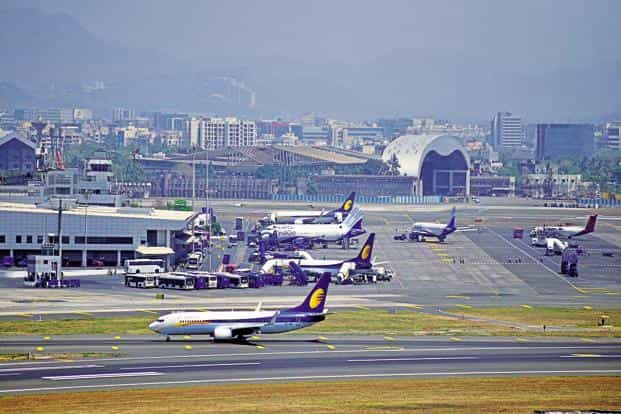The Aviation Ministry of India has revealed recently the intention of building two hundred new airports by 2040 in order to serve India’s increasing air passenger traffic numbers.
The air travel market of India is the fastest growing among the world. The factors responsible for this growth are the booming economy of India. Increase in the proportion of the middle-income households, a very healthy competition and government helping in the build up of infrastructure at the leading airports through their policy framework which is very supportive. As per IATA india stands at the ninth position in the largest civil aviation market and is supposed to reach third position by 2025.

As per the data by AAI, the national policy aims to facilitate around 400 million domestic booking of flight tickets by 2023 and it is expected to further increase to 600 million by 2028. With air passenger traffic expected to rise from 187 million in 2017-18 to 570 million by 2037, the number of planes operating in the sector is steadily increasing. Airlines are expanding their fleet size to meet current and projected traffic demand. According to data provided by Oliver Wyman, the commercial aircraft fleet is expected to grow to 1,547 by 2029, up from 604 in 2019. Furthermore, OEMs predict that India’s fleet will quadruple to approximately 2500 jets by 2038. (Boeing). This has resulted in the need to simultaneously improve and upgrade airport infrastructure as well as develop a robust ecosystem of after-market services to accommodate expanded operations.
The growth of the Indian aviation sector has the potential to have a multiplier effect on the country’s economy in terms of investments, tourism, and employment. The Indian government has devised an aggressive plan to promote the sector, including supportive policies and the expansion of airport infrastructure.
Infrastructure Built-up
The Indian government has announced a USD 1.83 billion investment in airport infrastructure development. The Ministry of Civil Aviation has launched the NABH (NextGen Airports for Bharat) Nirman initiative in accordance with the government’s plan. Under this initiative, the government intends to work toward a five-fold increase in airport capacity over the next 10-15 years, with the goal of handling a billion trips per year.)
The government of Uttar Pradesh has received approval under the same scheme to build the 5,000-hectare Noida International (NIAL) Greenfield Airport at Jewar. The airport will most likely have six runways and is scheduled to open in early 2024. NIAL is being developed by Zurich International Airport with the goal of becoming India’s leading airport in terms of customer service, outstanding efficiency, digital services, and commitment to minimizing environmental impact.
Furthermore, Prime Minister Narendra Modi’s government intends to privatise 30-35 airports over the next five years. Six airports have already been awarded to the private sector, with concession agreements signed. The Airport Authority of India is planning the next round of privatisation, which will include six to ten airports. These airports will be built in the same style as the world-class airports in Mumbai, Delhi, Kochi, Hyderabad, and Bengaluru, which account for more than 60% of the nation’s air traffic, according to Deloitte.
MRO Industry: Maintenance, Repair and Overhaul
India’s MRO industry is worth approximately USD 800 million and is growing at an annual CAGR of 8%, compared to a global average of 4%. The Indian civil aviation MRO market is worth close to USD 900 million and is expected to reach USD 4.33 billion by 2025, growing at a CAGR of around 14%.
The anticipated increase in aircraft fleet would improve MRO services. Between 2019 and 2024, the average age of India’s commercial aircraft fleet is expected to rise from 7.1 to 8.8 years (Oliver Wyman). As the importance of extending the life cycle of aircrafts and ensuring their suitability for service grows, India’s maintenance facilities will become increasingly important.
In April 2020, tax structures for MRO services were aligned with leading global jurisdictions in recognition of Indian carriers performing MRO services in Sri Lanka, South-East Asia, or the Middle East. Indian entities are exempt from additional taxation.
Greening the Indian Aviation
Given the expected growth in the Indian domestic travel market, decarbonizing the aviation sector is even more critical in order to meet Nationally Determined Contributions (NDC). According to the International Energy Agency, India will have the highest increase in energy demand of any country through 2040.
The civil aviation industry in India accounts for 1% of total carbon emissions. The Green Aviation Policy is a significant step taken by the Indian government to reduce this industry’s pollutant contributions. As the ninth-largest aviation market in the world, with more than 17 international airports, 80 domestic airports, 14 scheduled airlines, and 120 non-scheduled airlines, it is critical to develop and implement regulations to reduce CO2 emissions.
In line with the Green Aviation Policy, the World Economic Forum has launched the Clean Skies for Tomorrow (CST) initiative, which brings together Indian private and public institutions with a common goal of increasing the production and use of sustainable aviation fuel (SAF). The CST India initiative set a specific goal of transporting 100 million domestic passengers using at least 10% blended fuel with SAF by 2030.
In addition to supporting government policies, airports and airlines in India are implementing approaches to implement additions and changes, such as the use of renewable energy sources. GMR Group, which operates the Indira Gandhi International (IGIA) Airport in Delhi, has deployed 1,000 Taxi Bot-assisted flights since the installation of fuel-saving and carbon-emission-reducing equipment at its facility in 2019. Airlines benefited from this strategic initiative.

Supportive Government Policies
The government’s strong policy support has been a significant contributor to the growth of the aviation industry. The Ministry of Civil Aviation issued the first integrated National Civil Aviation Policy in 2016. (NCAP). The policy addresses all stakeholders, including airline operators, airport operators, air freighters, MRO players, and ground handling service providers.
The Regional Connectivity Scheme, also known as UDAN (‘Ude Desh ka Aam Nagrik’), was a critical component of NCAP 2016. The scheme aims to improve connectivity to India’s unserved and underserved airports while also making air travel more affordable and widespread. The scheme caps the airfare for a onehour 500km journey at Rs. 2,500 as an allinclusive charge.325 routes and 56 airports, including 5 heliports and 2 water aerodromes, have been operationalized as part of the scheme.
Promoting air connectivity could be beneficial to both the aviation industry and the economic development of unserved and underserved areas. Better regional connectivity can help meet consumer demand for convenient travel while also increasing the efficiency of businesses and trade. Similarly, airlines and airports may require high traffic volumes to stay in business. Given that the majority of the country’s passenger growth is concentrated in a few airports, it makes sense to connect the interiors and integrate them into the country’s air grid.
However, the Covid-19 pandemic has reduced short-term passenger traffic demand. The Indian aviation industry will make a strong comeback by leveraging the government’s support in the form of an encouraging ecosystem and infrastructure development through various initiatives. Furthermore, a gradual increase in passenger traffic and increased cargo traffic, aided by private investment, will boost the Indian aviation industry.
How the aviation industry plays into Modi’s global vision
With 187 million passengers flying in 2017-18, India is currently the world’s seventh largest aviation market. It is expected to become the third largest economy in the world within the next five years, trailing only China and the United States. This increase in numbers is directly related to the country’s rising affluence and middle class.
“The construction of India’s new airports will necessitate a capital investment of $40-50 billion.”
According to the aforementioned document, the capital investment required to build India’s new airports will be in the range of $40-50 billion, excluding land acquisition costs. The central government is said to be considering establishing a new fund with a starting corpus of $2 billion to support low-traffic airports in the early stages of expansion.
Mumbai is set to be one of the first cities to benefit from a new hub, with the first phase of Navi Mumbai International Airport set to open in mid-2020, as announced in January by Maharashtra Chief Minister Devendra Fadnavis.
As part of Modi’s “Made in India” initiative, India is building new airports and aiming to become more self-sufficient in aircraft manufacturing. The country’s commercial aircraft fleet, which stood at 622 in March 2018, is expected to grow to 2,359 by March 2040.
Are India’s airport plans grounded in reality?
When it comes to its aviation market, India has never been more adamant, but are its goals entirely attainable?
Speaking at a summit roundtable, Alexandre de Juniac, CEO of the International Air Transport Association, suggested that building a new airport in Mumbai within five years would be a difficult task.
Others have been more open in their doubts about Indian airports’ ability to meet the surge in demand. According to Indian aviation expert Neelam Matthews, “all this talk of India becoming the third-largest aviation market may not happen, because the infrastructure may not be able to come up.”
Then there’s India’s mixed track record when it comes to previous aviation promises to consider. Modi unveiled the Regional Connectivity Scheme in 2017, with the goal of connecting smaller towns in the country to the country’s aviation network via subsided new routes.
Future of Airports Of India
Airport development, in general, has followed the same blueprint since their inception. However, with emerging technologies, new regulatory frameworks, new types of passengers, climate change, and the pandemic, the tides have turned. Given such a scenario, it is time to reconsider future plans.
Passenger centricity is the single most important factor determining an airport’s or airline’s success or failure. As a result, combining and integrating passenger behaviour with advanced technology and design is now the best recipe for aviation to lay the groundwork for long-term change.
Because the pandemic is not yet over, the measures that the sector is taking now will become mainstream once we all reach a more stable position following COVID. Technology unquestionably plays an important role in this situation. As soon as the passenger arrives at the airport terminal, paper ID and boarding passes may be replaced by biometrics, particularly facial recognition technology, which may be used to enrol the passenger at entry points. We can already see a shift toward web check-ins, self-check-ins, self-baggage tags, and baggage drops to reduce passenger contact with surfaces, objects, and airline ground staff. During security checks, remote screening can also become a regular practise.
AI, machine learning, and IoT can be used to collect and analyse data on a daily basis, which can then be used to generate meaningful insights for improved security, safety, and passenger experience. Because AI can track travel history, current location, and destination, passenger health profiles could be generated in the event of a pandemic. AI-assisted recommendation systems could also be implemented for passengers who require additional levels of health screening.
Airports no longer need to manage passenger footfall; instead, they must plan the volume, understand the pattern, and address issues to improve overall experiences. This is only possible when traditional ways of working are combined with creative problem-solving abilities. The goal is to’rebuild better’ following the pandemic-induced slump. There is no doubt that technology has the potential to transform both airport operations and the passenger experience.
Robotics, Blockchain Technology, Augmented Reality and Virtual Reality, Biometrics, and Wearable Technology are all set to change the aviation space forever in the future. Few international airports have implemented such technologies.
Outlook
There are numerous opportunities in the Indian aviation sector that are just waiting to be explored. India is perfectly positioned to become a leading hub for maintenance, repair, and operations (MRO). Adequate policy support and rising demand are already revealing enormous investment opportunities. To top it all off, the success of the PPP model will spur investment in both existing and new airports.
It is critical to note that airports provide all-around access to critical infrastructure and services that facilitate air travel. Airports can also play an important role in economic development at the local, national, and regional levels. As a result, effective and efficient airport development and operations are critical for the long-term development of air transport in particular and the economy as a whole. Airport infrastructure is critical to the overall transportation network and directly contributes to a country’s international competitiveness and the flow of foreign investment.






